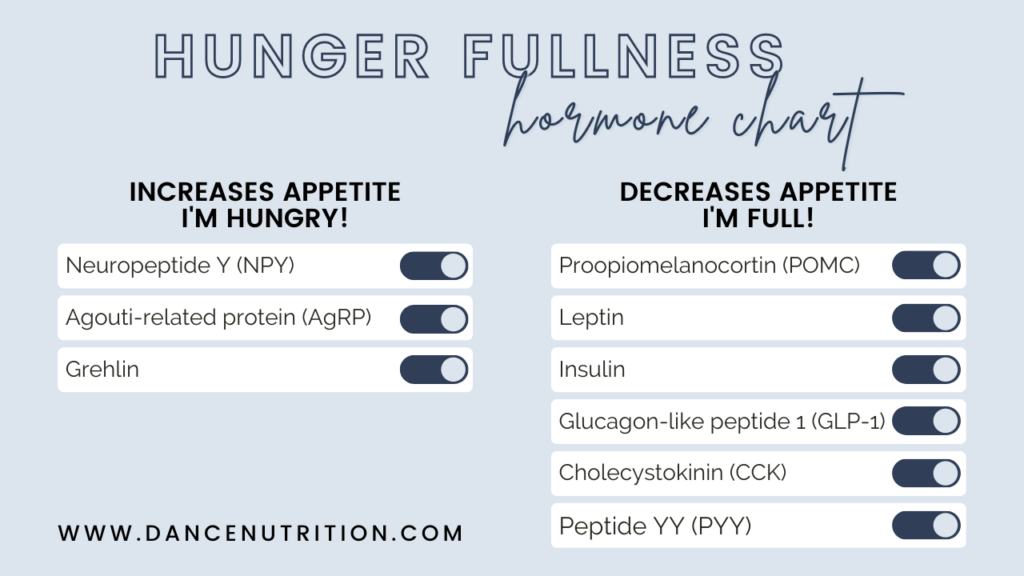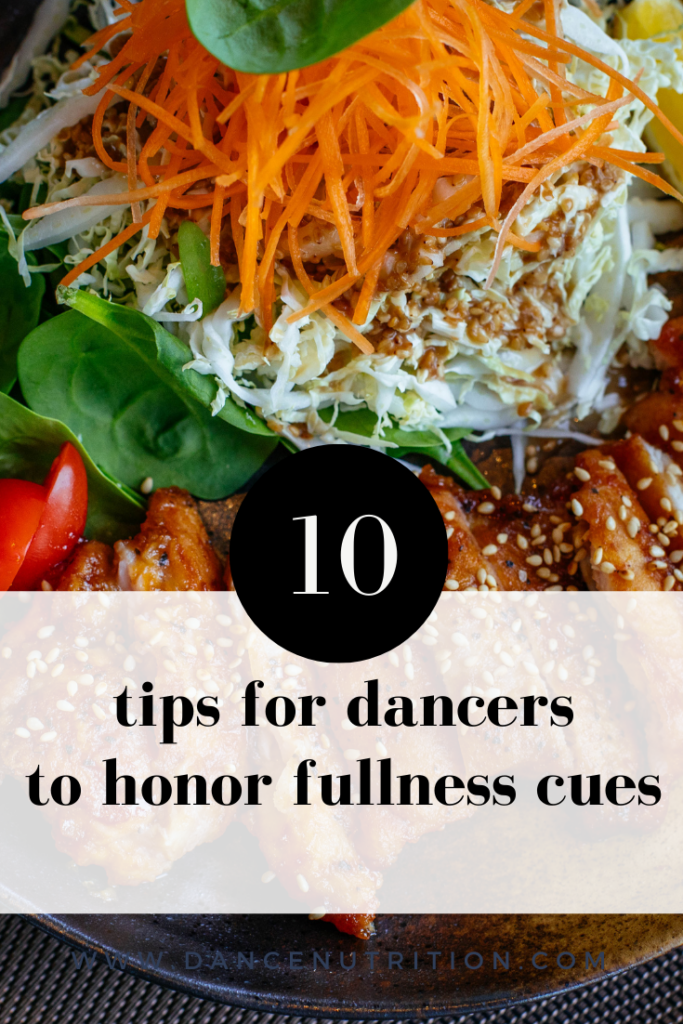Imagine this: you’re sitting at the table and nearing a 7 or 8 on The Hunger Fullness scale. But instead of stopping, you keep eating.
Are you having difficulty honoring your fullness cues? Are you constantly eating past the feeling of comfortable fullness? Do you find yourself “over”eating more times than not? In this post, we’ll discuss what it actually means to feel full after eating and how to regain the ability to feel when enough is actually enough.
The Biology of Fullness
In a previous article, I discussed the hormonal regulation of our appetite. To briefly recap, various hormones, specifically ghrelin and leptin, communicate messages between our digestive tract and brain. Ghrelin (AKA the “hunger” hormone) is released in response to the natural dips in energy that we experience throughout the day. Ghrelin tells us when it’s time to eat. Fun fact: levels of ghrelin even increase at the mere sight of food.

Hormones and Appetite Regulation
As we eat, levels of ghrelin decline while leptin (the “feel full” hormone) does the opposite— increases as we progress in our meal.
Since our body’s fat cells are the site of leptin production and release, a low percentage of body fat means low levels of circulating leptin. Levels of circulating leptin also decline with weight loss and in response to restrictive dieting. Remember: you’re body’s biologically wired to fight famine, even when that famine is self-induced through dieting. If your body isn’t obtaining the food it needs for survival, then it’s going to tone down the hormone that’s telling you when you’re full.
Fear of Fullness
Eating past fullness is common when breaking food rules and rebuilding your relationship with food. Your level of fullness will shift as you nourish your body more adequately. This physical discomfort is a very normal (and temporary) response when working through the steps toward building a more supportive relationship with food.
Unfortunately, behaviors like eating past fullness, “over”-eating, and even feelings of bloat are largely demonized in today’s world. As a result, it’s common to fear fullness. Even a normal degree of fullness can feel like you’re eating “too much”— triggering food guilt and anxiety. This negative association with fullness exacerbates a cycle of feeling extremely in control around food (to the point of restriction) to ultimately feeling very out of control around food (and eating past fullness). While for most, the latter is a biological response to deprivation, for some, it can drive restrictive tendencies and worsen symptoms of an eating disorder. For dancers who struggle to move past this fear of fullness, it’s encouraged that you consult with a provider (like a Registered Dietitian Nutritionist, or mental health therapist).
Feeling Fullness
Feeling full is our body’s response to adequate nourishment. This is SUPER important, especially because diet culture often tells us that feeling full (or “feeling bloated”) is a bad thing (spoiler: these feelings are often normal, but if you’re questioning a digestive disorder, then read this).
But fullness doesn’t have to be so straightforward. We can experience feelings of fullness in a multitude of ways. When you begin to feel full after eating, you might experience:
- Less obsessive thoughts about food.
- Feeling less anxious.
- Increased ability to concentrate on tasks.
- Feeling more equipped to move through your day.
- Feeling energized.
- Feeling pleasant and calm.
- Noticing that the taste of food diminishes as you continue to eat.
Without judgment, can you identify how your body might be communicating fullness? To start, decipher between physical fullness and mental fullness. We can easily eat a large salad for dinner and feel the somatic feedback from a distended belly. But if we’re craving a juicy steak, then the salad will never truly satisfy us. I often consider mental fullness (AKA satisfaction) the fourth macronutrient on our balanced plate. Here’s an article that dives more into this topic.
Now, you can totally tweak your salad to increase its staying power. We define a food’s staying power by its ability to keep you feeling full for an extended period (such as 2-3 hours). In regards to the salad, top it with cheese, sunflower seeds, and dressing. Add a side of toasted pita and you’ll create a balanced meal that incorporates the three macronutrients (protein, carbs, and fat), each of which plays a role in fullness and satisfaction.
If a fear of fullness is preventing you from moving forward in this work, then I invite you to explore the various scenarios that might happen if you eat to a point past comfort. Compassion is key here— consider how you would speak to yourself as a child or a close friend. Remember that feelings of over-fullness are temporary and as I discuss here, non-restrictive steps can be taken to ease the discomfort.
10 Easy Steps to Feel Fullness
If you’ve unraveled any lurking fears of fullness and simultaneously increased your meal’s staying power in an attempt to promote true fullness, but you’re still struggling to stop eating when feeling full, it’s time to assess your level of satisfaction. As previously mentioned, continuing to eat past fullness might be a sign that you’re making up for past food deprivation. This, along with a few other tips, can be used to help you become a pro at honoring fullness. Let’s dive in:
#1: Eat enough
It’s common for dancers to unintentionally undereat. Busy schedules and high levels of physical activity can diminish hunger cues. And if you’re not eating enough throughout the day or week, then you’re likely throwing off your fullness cues as well. To start, take a look at this article, which dives into a dancer’s calorie needs.
#2: Reassess your food rules and honor food preferences
Often, but not always, instead of eating certain foods for enjoyment, dancers choose various foods (for example, salads) because they’ve heard that those foods are “healthy.” But if you’re not enjoying the food you’re eating, then you might feel a void later on. This can leave you with the desire to keep eating, despite what your physical fullness cues are communicating. Here’s an article that dives into the differences between food choices and food rules.
#3: Think about fiber, but don’t go overboard
Fiber is a functional component of most plant-based foods and promotes lasting energy, digestive regularity, and fullness between meals. However, overdoing it on fibrous foods can leave you experiencing fullness too soon into eating such as with a distended tummy and gas.
All sources of fiber are not created equal. Some diet foods boast higher levels of fiber but contain ingredients that can leave you with discomfort. Check out this article that dives into fiber and how you can increase your daily intake of naturally occurring fibrous foods.
#4: Reframe emotional eating
Diet culture frames emotional eating in a negative light. The truth is, food should be emotional. First, reclaim what it means to eat emotionally (here’s an article about it). Then, consider a journaling practice to identify what feelings you are trying to fill when continuing to eat past fullness. There might be other coping strategies that we can develop to help navigate feelings of distress like listening to music, taking a walk, and reading a book.
#5: Reconsider boredom
Boredom eating is another common example of a coping strategy used during feelings of discomfort. There’s nothing inherently wrong with eating when you’re bored and there should be no shame around it (we all do it!). But since eating past a comfortable fullness doesn’t leave us feeling great physically, you’ll want to develop other coping strategies to get us through feelings or experiences of boredom or discomfort.
#6: Use the hunger fullness scale
As a tool for progress, check in with yourself throughout the day. Aim for a comfortable fullness (around a 7 or 8). The same goes for hunger. Avoiding extreme hunger might involve some flexible meal planning. Click here to more about the hunger fullness scale for dancers.
#7: Tune into mindful eating
When time permits, mindfulness enables you to connect to the present moment. As you do this, you’ll process the information more clearly and be better equipped to make decisions that serve you here and now. This can be a game-changer for feeling fullness! Check out my top 10 favorite tips for mindful eating.
#8: Remind yourself: you can eat again later, tomorrow, the next day, and beyond
It’s easy for us to enter that mindset of, “Starting tomorrow… I’ll eat SUPER healthy!” However, biology will take over as you fight biological and psychological restrictions. Enter unconditional permission. When we grant ourselves unconditional permission to eat the foods that we love, then we ease the weight that food holds over us. Reassure yourself that you can eat whatever you want (and what is accessible to you) the next time you’re feeling hungry.
#9: Make space for the sadness of enoughness
Even after you’ve discovered how to identify feelings of comfortable fullness, what happens if you want to continue to eat simply because the food tastes good? To take it a step further, do you feel a bit anxious or sad at the thought of NOT eating anymore?
Sometimes, when food tastes SO delicious, it can be sad to stop eating it! If you can pack leftovers, then great! The taste of food diminishes even after the first three bites. Saving the remaining portion for a time when you’re feeling hungry again can give you double the excitement!
But if you cannot pack leftovers, then consider sitting with your sadness. This is normal! Food is fun. It’s always sad to stop something that is fun. Remember: the sadness of ending your meal before becoming overfull will only last a few moments. Ask yourself: can I tolerate this temporary sadness?
#10: Drop the guilt… you’re not addicted to food
I covered the topic of food guilt in a previous article. Disordered eating and food guilt are both normalized in our culture. It’s nearly impossible to not have a heightened awareness of foods that we often think of as being less nourishing (or, less “clean”). To rid our minds of these negative associations, like guilt and shame, around food, we must unlearn the messages of diet culture.
You have permission to eat your entire meal (or snack). Forget about serving sizes and instead, discover portion control from within. Here’s an article to help with this.


,


